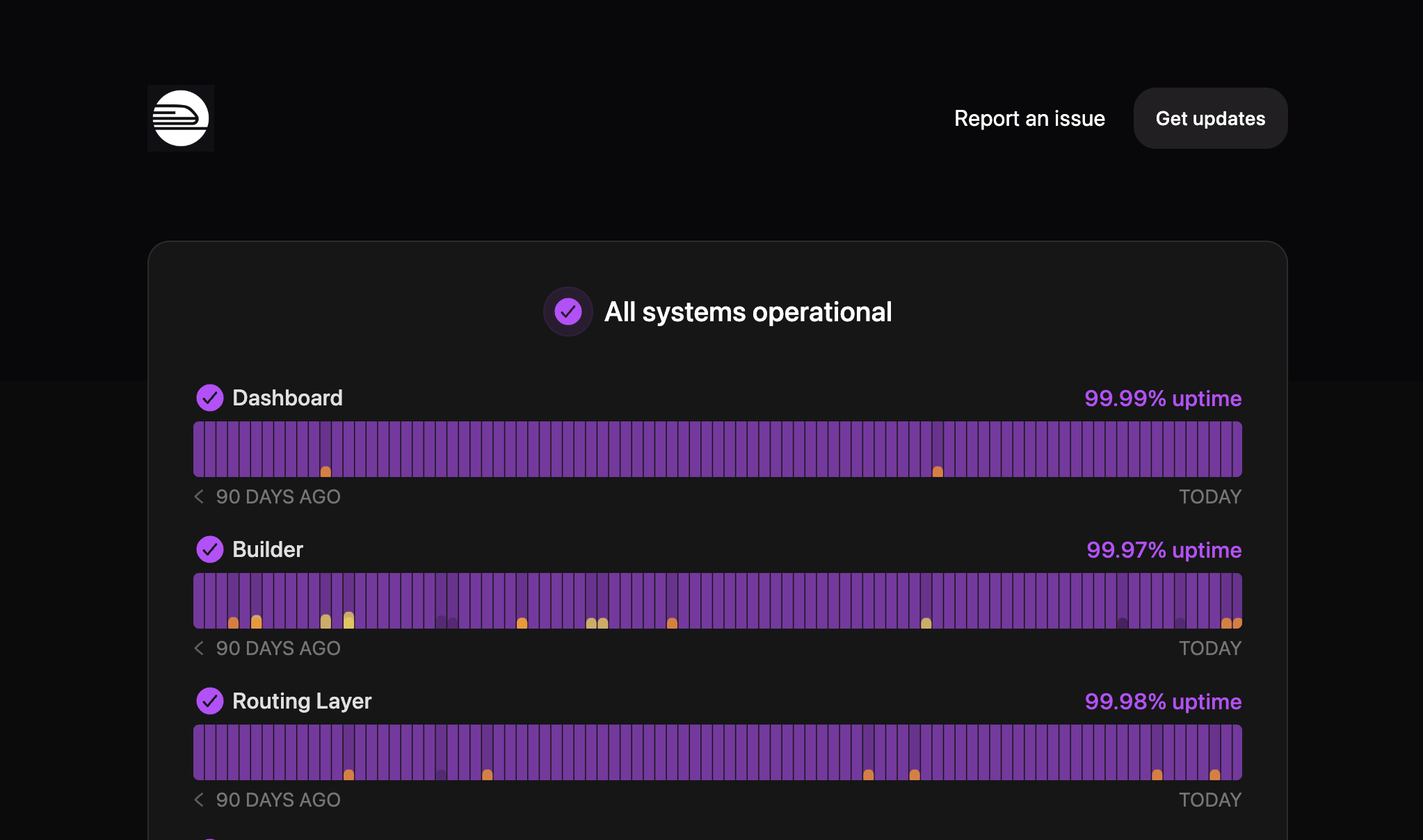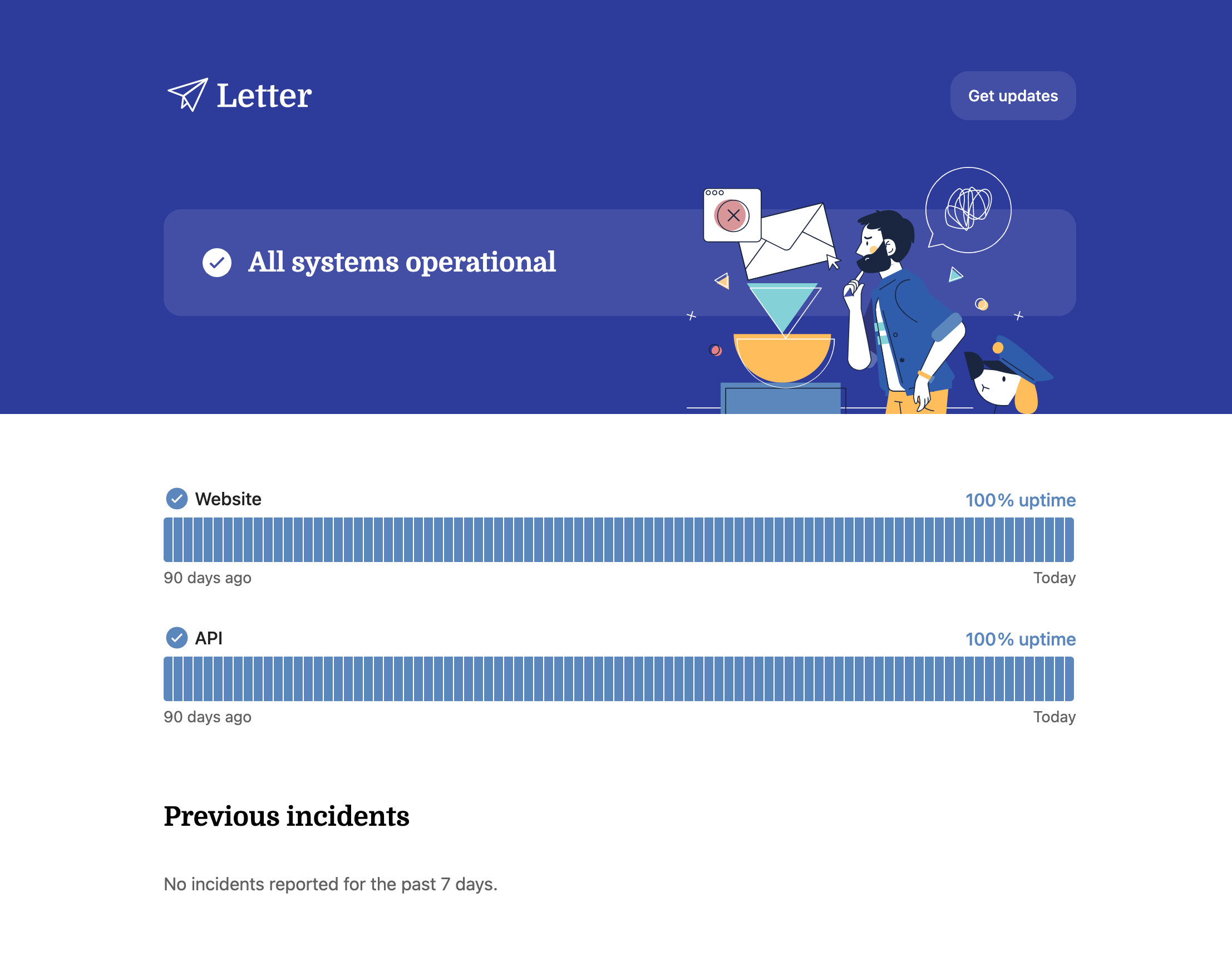We’ve Tried the Best Self-Hosted Status Pages for 2025

Helpful Summary
- Overview: We’ve assessed the best self-hosted status pages for 2025, which have become crucial for online businesses. We prioritize platforms that offer real-time updates about website or application performance, significantly enhancing customer satisfaction and loyalty.
- Why you can trust us: At Instatus, our expertise in creating top-notch self-hosted status pages is backed by our deep understanding of real-time system status monitoring. This expertise ensures that our services are both reliable and insightful, helping businesses foster trust and reduce support team workload.
- Why this is important: Self-hosted status pages are vital for reducing support team workload, offering full control over branding, providing essential information during emergencies, improving service quality, and enabling quick problem resolutions.
- Action points: Choose the right self-hosted status page based on your needs for functionality, ease of use, customization, cost, control, and resilience.
- Further research: Continually evaluate and update your strategies for using self-hosted status pages to stay abreast of technological advancements and customer expectations.
Need Help Finding a Self-Hosted Status Page?
Having a status page is valuable for any online business. You’ll be able to communicate with your users when it matters most–during an incident.
Self-hosted status pages are important for keeping users, customers, and stakeholders informed in real time about any disruptions, outages, or issues that may affect the availability or performance of your website or app.
In this Instatus article, we're going to look at the top-rated self-hosted status pages and why they are so important for customer satisfaction and loyalty. We'll explore the unique benefits these pages offer and how they're helping businesses adapt to the fast-paced changes in our world.
Why Listen To Us?
At Instatus, we're experts at making top-notch self-hosted status pages. We know the ins and outs of keeping track of your system's status in real-time. This expertise guides everything we do, making our services both reliable and insightful.
You can count on Instatus for clear and regular updates about your system's health. This builds trust with your customers and means fewer calls to your support team. We're dedicated to offering the best ways to monitor and show off the status of your services.
What Are Self-Hosted Status Pages?
Self-hosted status pages are tools that help you check if your websites or apps are working properly. You’ll be able to publish updates on any ongoing incidents, showcase your website’s historical uptime and performance, and notify your users about maintenance periods all from a unified page.
These tools can perform tasks like automatically tell you when your website is not working, show you graphs of how well your website is running, and send messages to you or your customers through emails or texts. You can also change how they look and work to fit what you need.
Having your own status page is useful. It allows you to talk openly with your customers or team when there's a problem, which helps build trust. This is great if you need special features that aren't available with other services, or if you want to control how you share information about your service.
Why is a Self-Hosted Status Page Important?
Self-hosted status pages are essential, especially for businesses offering online services or applications mainly because of the following:
Customization and Branding
These pages give you control over hosting and customization, boosting your company's brand. Aligning your status page with your branding not only sharpens your identity but also blends it smoothly into your digital world. This customization can skyrocket your brand's reputation, underscoring your commitment to openness and customer care.
Custom Monitoring and Alerting
With self-hosted pages, you get more nuanced monitoring and alerting systems. You can tie your status pages with a variety of monitoring tools and whip up alerts that fit your unique needs. This heads-up style of communication, particularly during service hiccups, doesn't just keep trust with customers but also builds brand loyalty.
Data Privacy and Security
Hosting your own status page means more grip on your data, boosting privacy and security. This matters a lot for firms handling sensitive information or in industries with tight data protection rules. By using self-hosted solutions, businesses can ensure that their data is stored and managed in compliance with their security policies. Data privacy and security are essential for self-hosted status pages, not just for cost and control, but also for sticking to data privacy laws like GDPR.
Criteria To Consider When Choosing Self-Hosted Status Pages
Functionality and Ease of Use: Think about how the status page works and how easy it is to use. Some self-hosted options might not be as advanced or user-friendly as SaaS versions. Customization and Branding: How much you can make the status page look and feel like your brand is important? This includes changing the design, messages, and overall experience for the user. Cost: Going the self-hosted route might seem cheaper since you're just paying for server space. But, there are often hidden costs like keeping the system up-to-date and making changes, which can add up over time. In the end, a SaaS solution might actually be more budget-friendly. Control: If you host the status page yourself, you're in charge. You can tweak the software to fit your needs. This is great for companies with specific needs or those who like to have close control over their tools. Time and Resource Investment: Setting up and running your status page can take a lot of time and tech know-how. This includes getting the server ready, keeping everything running smoothly, and updating aspects when needed. Not to mention managing downtime can be a hassle, but with Instatus, you can easily communicate with your customers about scheduled maintenance periods, keeping your customers informed when parts of your service will be temporarily unavailable.
6 Best Self-Hosted Status Pages
0. Instatus
Instatus isn't self-hosted, but you can use it to get a quick & beautiful status page that's free forever.
Instatus makes it super easy and fast to create status pages. You can create a beautiful status page in just 10 seconds, and it's budget-friendly too! You only need to upgrade to get a custom domain. That's why Instatus is the top choice for anyone looking for a quick and affordable status page.
Services Offered
- Monitoring Types: Instatus updates the status page during outages, integrating with monitoring services for automatic updates based on service data.
- Alerts & Notifications: Provides unlimited customers with free notifications via Email, RSS, SMS, and Webhooks, keeping them informed about service status updates through their preferred channels.
- Integration with Monitoring Services: Works well with tools like Pingdom, New Relic, Uptime Robot, Runscope, Freshping, and Datadog.
- Customization and Branding: You can make your status page match your style. Change the language, the website address, and the design as you like.
- Incident management: Offers on-call calendar creation, escalation policies, and incident management, enabling users to create, acknowledge, and resolve incidents from Slack, with collaboration features like incident leads and activity tracking.
1. OpenStatus
OpenStatus is a free and open-source tool for creating status pages. It's great for small startups that want to keep their customers informed about service issues. It also has monitoring features so that you don't need to have your teammates update the page manually.

Services Offered
- ** Monitoring**: OpenStatus can check your services automatically and update your status page when something goes wrong.
- ** Custom domain**: You can use your own domain name for your status page.
- ** Email Subscription**: Get updates about your services (through email only).
- ** Maintenance periods**: Let your users know when you're planning to do maintenance on your services.
2. Cstate
Cstate uses a JAM stack. It’s statically generated, which means you can easily host it for free on Netlify or Github Pages. It doesn’t have a dashboard though, so to update you’ll need to update incidents using Github, and your host will auto publish it. Another way is to use Netlify CMS but it requires additional setup.
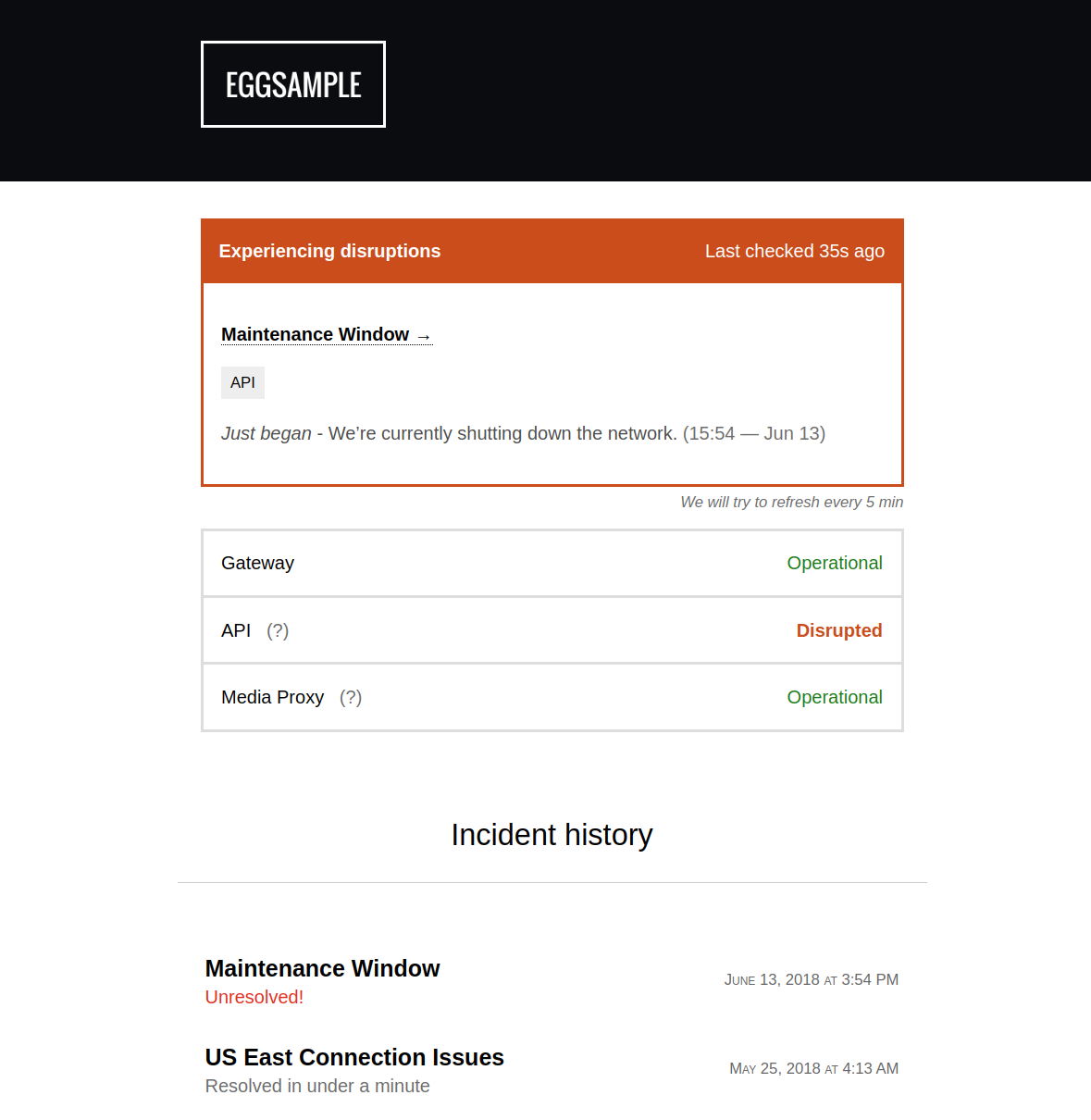
Services Offered
- Custom Domain: Use your own domain name for your status page.
- Markdown Support: Write your incidents in Markdown.
- Free Hosting: Host your status page for free on Netlify or Github Pages.
- Simple design & fast to load: Cstate has a simple design that's easy to read. It's also statically generated, so it loads quickly.
3. Cachet
Cachet is a no-cost tool for making status pages. It helps businesses quickly tell their customers about any service issues or planned updates.
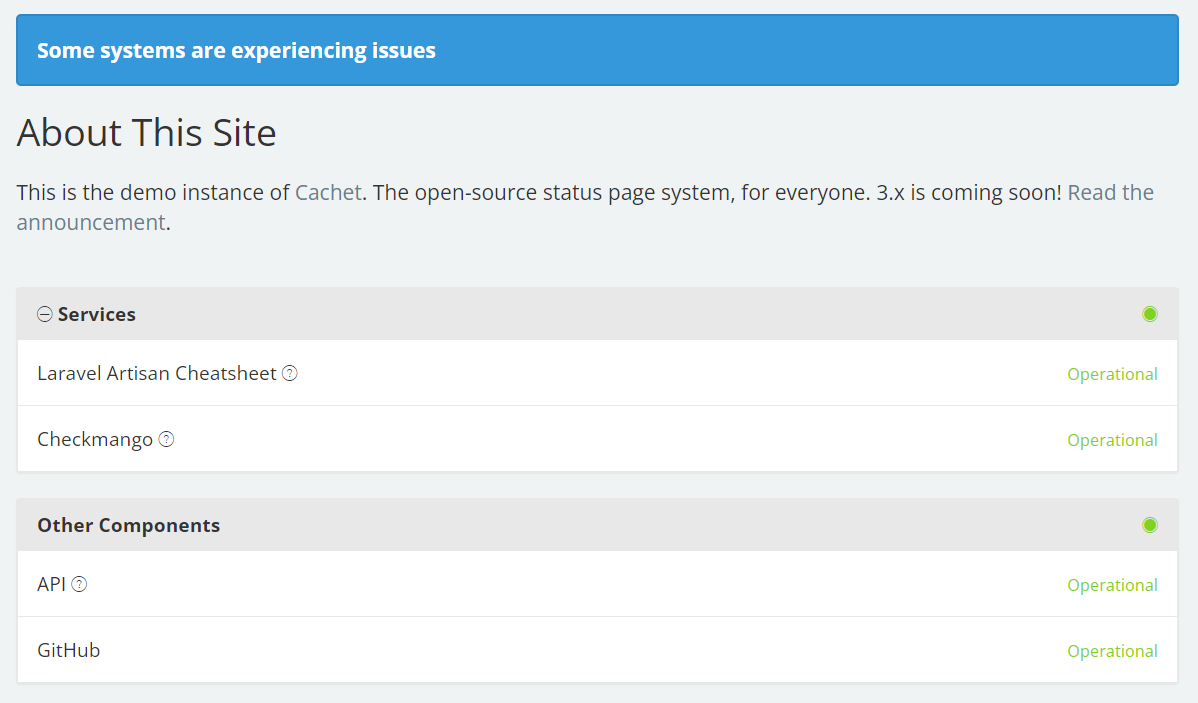
Services Offered
- Customizable Design: This feature lets you change the look of your status page.
- Language Support: Cachet works in many languages.
- API for Automation: Use the API to update your page automatically.
- Scheduled Updates: Easily update people when you're planning service changes.
4. Statping
Statping is a free and open-source tool for keeping an eye on different web services. It's great for setting up your own status page to track services like websites and apps.
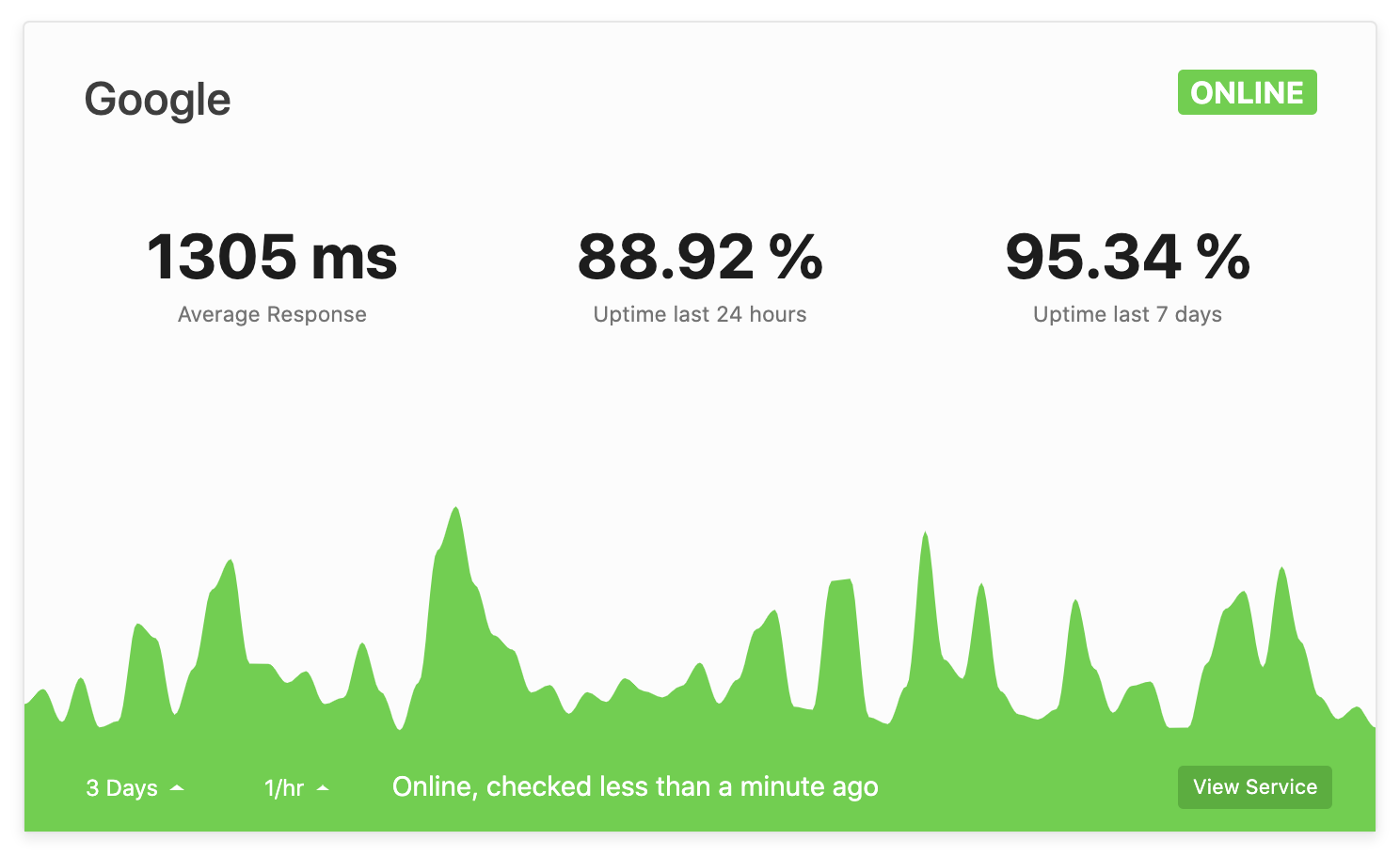
Services Offered
- Visual Frontend: Get alerts when your services stop working.
- Custom Styling: Change the colors and look of your status page.
- Service Groups: Organize your services into different groups.
- Notifiers: Get instant alerts through popular platforms like Slack, Discord, Telegram, email, and others when something goes offline.
5. Uptime Kuma
Uptime Kuma lets people easily check how different services are doing. It updates regularly, every 5 minutes, so you always have the latest information.
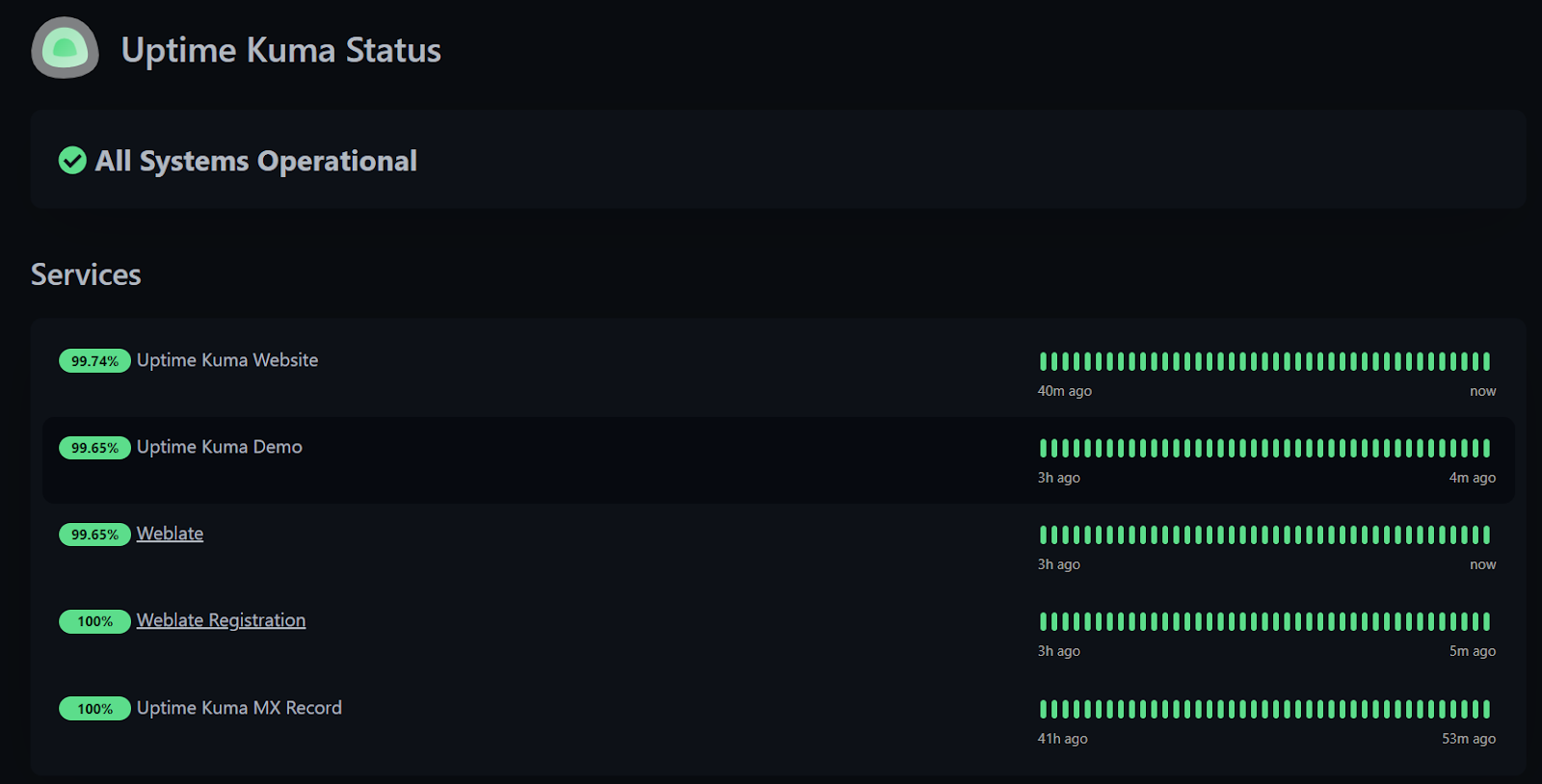
Services Offered
- Status Page: Easy-to-understand pages that show how your services are running.
- Badge Feature: Shows service status with simple badges.
- Docker Container Monitoring: Keeps track of Docker containers.
- Maintenance Management: Helps plan and organize service repairs and updates.
6. Vigil
Vigil is a straightforward and effective tool you can set up yourself for managing status pages. It's great for keeping an eye on your company's systems, letting you know when something's not working right, and for communicating through different channels such as Email, SMS, Slack, and Telegram.
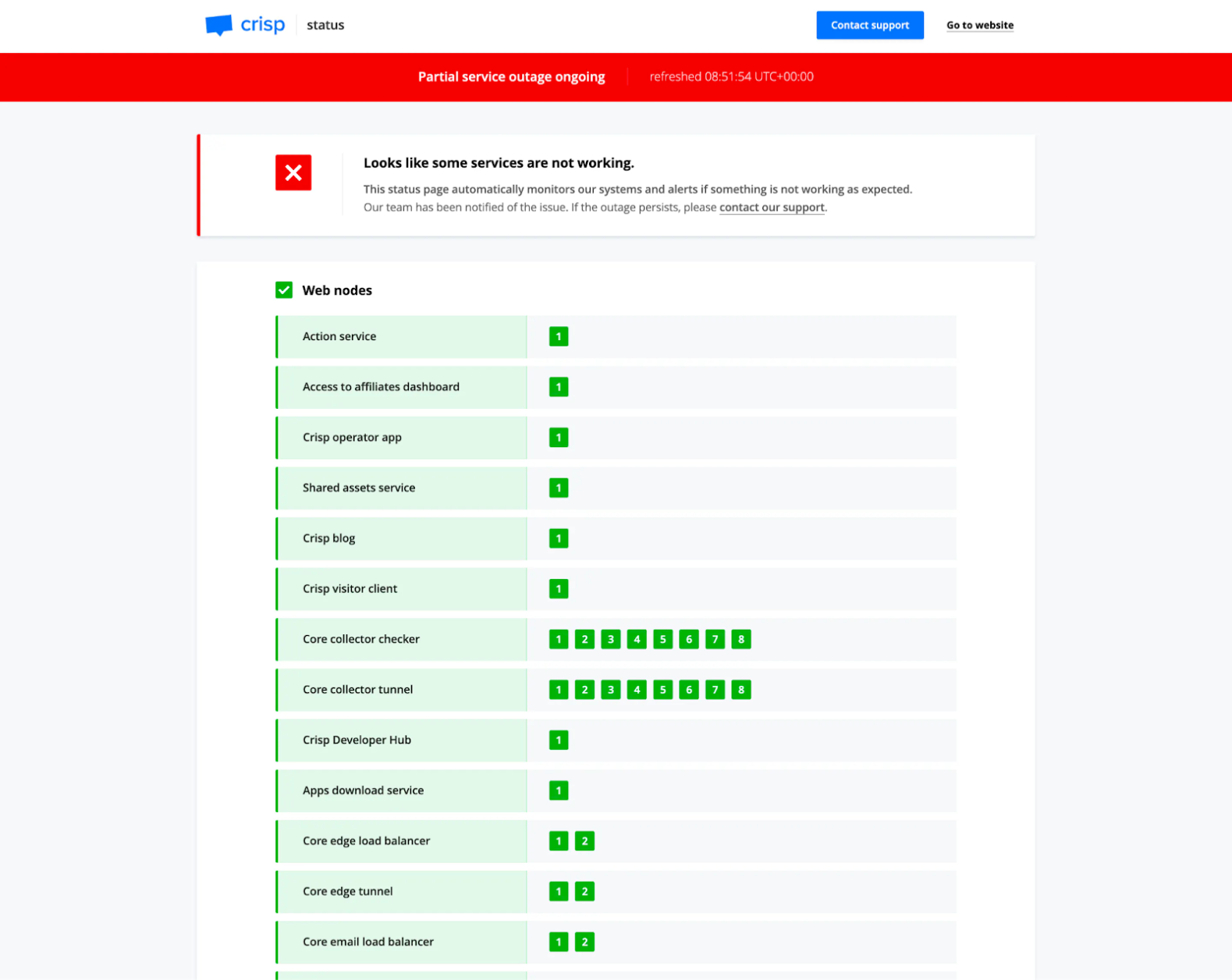
Services Offered
- Automatic Monitoring: Vigil keeps a watch on your systems for you.
- Notifications: It tells you when a system stops working or starts working again. You can get these alerts through Email, Twilio (SMS), Slack, Zulip, Telegram, Pushover, Gotify, XMPP, Matrix, Cisco Webex, and Webhooks.
- Custom Status Page: It creates a status page that you can put on your own website for everyone to see, like "https://status.example.com."
Conclusion
To wrap up, we recognize the significant role self-hosted status pages play in the operations of businesses in 2025. These pages provide businesses control over secure customer info, monitoring services, and promptly inform customers about any service issues.
With that, adopting self-hosted status pages is becoming a smart choice for maintaining customer trust and keeping the business steady through challenges.
Instatus's ability to be self-hosted gives you more control and customization options. This is important for keeping your data safe and making sure your status page fits your company's style.
Connecting with different monitoring tools and services is easy with Instatus. This makes managing status pages simpler and gives users up-to-date and complete information.
To sum up, Instatus is one of the top choices in 2025 for businesses that want a strong, customizable, and safe status page solution. It's crucial for companies that want to be clear about their operations and build stronger customer relationships.
Using Instatus is a smart step for businesses looking to improve their online presence and connect with users better. Create your status page today!
Get ready for downtime
Monitor your services
Fix incidents with your team
Share your status with customers


